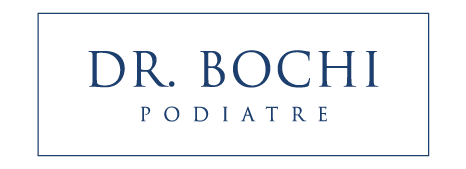While most patients treat their heel pain using standard therapies, some develop chronic heel pain that requires more advanced treatment options. At Dr. George Bochi’s Podiatry Clinic, we use a number of sophisticated therapies.
There are many different treatments advertised as “cures” for heel pain, and trying to determine which one offers the best solution can be confusing. In reality, each treatment has its own advantages and disadvantages. Below, we list each therapy and provide a link to a more detailed description outlining the pros and cons of each one.
Orthotics for Heel Pain
A number of studies recommend the use of orthotics to treat heel pain, especially heel pain caused by plantar fasciitis. These studies also show that orthotics must be prescribed in a very specific manner to be most effective in treating heel pain.
Ultrasound-Guided Injections
Steroid injections are a common and proven treatment for quickly reducing pain and inflammation associated with plantar fasciitis. For more chronic cases of heel pain, we often administer ultrasound-guided injections. This means we use ultrasound imaging techniques to see exactly where the injection is being placed, which helps improve the outcomes.
Using Micro-Injuries to Stimulate Healing
Chronic plantar fasciitis can lead to thickening or scarring of the plantar fascia. This condition is known as “plantar fasciosis.” When this occurs, standard treatments for plantar fasciitis tend to be less effective.
Newer treatments for plantar fasciosis focus on creating controlled micro-injuries to the plantar fascia. This triggers minor internal bleeding within the fascia, which stimulates the body’s natural healing process. Proteins, blood, and oxygen rush to the site, initiating a metabolic process that promotes healing through the formation of new connective tissue.
There are several therapies that stimulate healing by creating these micro-injuries. These include:
- Ultrasound-Guided Percutaneous Approach for Plantar Fasciitis (Dry Needling)
This is an innovative treatment that has shown promising results. It is a quick, minimally invasive, and cost-effective solution available at Dr. George Bochi’s Podiatry Clinic. This technique was developed by the Laboratory of Experimental Medicine at the University of Genoa in Italy.
In a study published in 2008, researchers achieved a 95 percent success rate in providing complete relief from plantar fasciitis symptoms, with the relief lasting nearly a year at the time the study was published.
- Extracorporeal shock wave therapy uses high-power shock waves to treat heel pain and, like dry needling, it is a non-invasive and non-surgical treatment option for heel pain associated with chronic plantar fasciitis. The shock waves work by stimulating the healing process and promoting blood flow to the affected area.
Radiofrequency ablation for the treatment of plantar fasciitis.
Radiofrequency ablation is a minimally invasive procedure used to treat conditions associated with chronic heel pain and other nerve-related issues. This procedure does not treat plantar fasciitis or plantar fasciosis, but instead blocks the nerve signal that causes the pain. Essentially, the treatment involves calming the nerve that transmits the pain signals associated with plantar fasciitis. With radiofrequency ablation, the heel is numbed with a local anesthetic, and an electrode is inserted to disrupt the nerve electrically. Surrounding tissues are not damaged, and the patient can walk immediately afterward. We currently do not offer this treatment as we believe there is insufficient evidence to support its use as a replacement for other treatments. We will update this page as new information becomes available.
Platelet-Rich Plasma (PRP) for the treatment of plantar fasciitis and Achilles tendinitis.
PRP (Platelet-Rich Plasma) is a relatively new procedure that involves drawing blood from the patient’s arm and then centrifuging it to separate the platelets. The platelets are then injected into the damaged tissues of the plantar fascia or Achilles tendon. While we can offer this procedure to our patients, there is limited evidence demonstrating its effectiveness. A recent study showed that cortisone injections are more effective.
It is believed that platelets contain healing proteins that are supposed to stimulate the healing of the damaged fascia and tendon. Currently, studies on PRP are conflicting. Some studies show fairly good results, while others demonstrate no significant improvement. We are closely monitoring new studies and will update this page as new information becomes available. Currently, we sometimes refer our patients to an interventional radiologist for PRP if their Achilles tendinitis has not responded to other treatments.
Topaz Radiofrequency Coblation and Cryosurgery for the Treatment of Plantar Fasciitis.
In recent years, both Topaz Radiofrequency Coblation and Cryosurgery have been promoted for the treatment of chronic plantar fasciitis. However, at present, there are no studies clearly indicating that they are effective in treating plantar fasciitis. The companies promoting these procedures claim that they work similarly to shockwave therapy or dry needling by injuring the plantar fascia to stimulate healing. However, they are considered more aggressive treatments as they require an incision. While our team has the skills to perform these procedures, our opinion is that there is still insufficient evidence showing that these treatments are more effective than more established options. Currently, most studies are conducted by those with a financial interest in the success of these treatments. We will update this page as new information becomes available.
We can help you choose the best treatment for your heel pain. Contact us to schedule an appointment at our podiatric clinic in Montreal.
© 2019 Dr. George Bochi, Podiatrist
